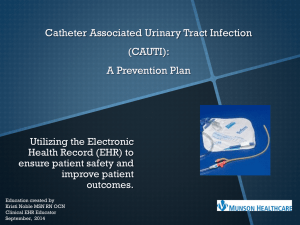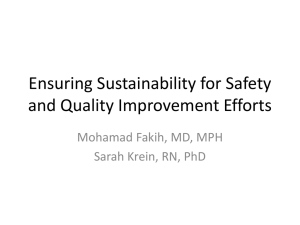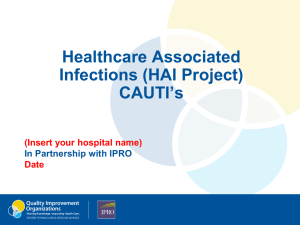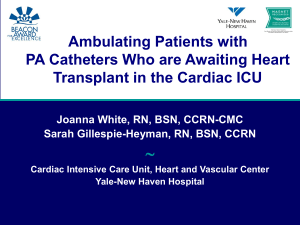PC- Nurse-Driven Urinary Catheter Removal
advertisement
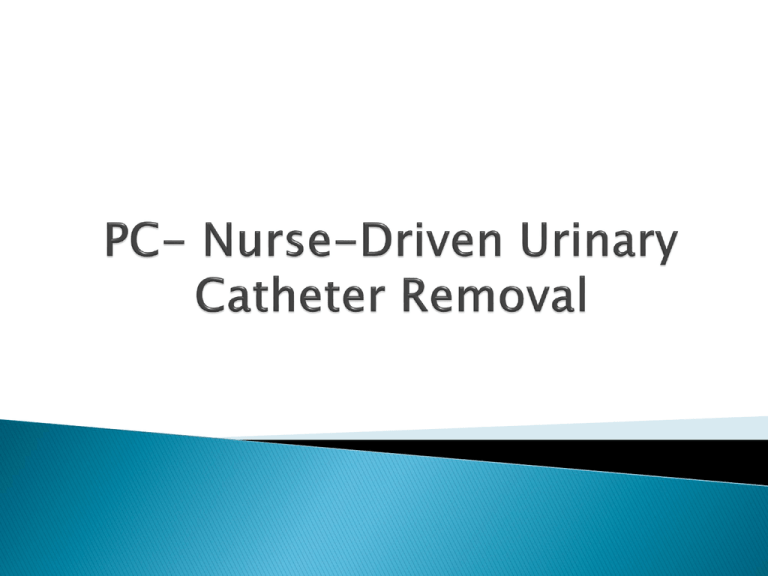
Purpose: Reduce catheter associated urinary tract infections (CAUTI). Definitions: CAUTI – A nosocomial infection that can develop in patients with an indwelling urinary catheter. Policy: Patients meeting specific assessment criteria will have the urinary catheter removed by a nurse. Procedure: 1. Assess the need to continue urinary catheter as part of their ongoing assessment using the Nurse-Driven Urinary Catheter Assessment. (See Addendum A). 2. If none of the specified indications for continued catheter use are met, the catheter will be discontinued by the nurse. 3. Continue to reevaluate and assess the need to reinsert the urinary catheter following removal of the urinary catheter. 4. Contact the patient’s physician for further orders if patient is unable to void following catheter removal. Patient/Family Education Patient and/or family will be educated on: 1. Risk of complications associated with urinary catheters. 2. Importance of adequate fluid intake after removal of urinary catheter . 3. Measurement of intake and output to be done to assess the patient’s ability to empty bladder after removal of urinary catheter. Documentation: Nurse to document assessment and removal of urinary catheter and continued reassessment post removal, in the patient’s medical record. Assess Patient for Indications for Continued Catheter Use: Aggressive treatment with diuretics Gross hematuria within Spinal cord last 24 hours injury/significant immobilization issues Accurate monitoring of Urologist involved in urinary output case/catheter placed by Chronic long term urology/difficult indwelling catheter Management of urinary catheterization incontinence in patient History of urinary with Stage III or greater Post op/post procedure retention pressure ulcers (less than 48 hours prior) MD order to continue End of life/comfort care Presence of epidural urinary catheter catheter Indications present? Yes or No Are any indications present? If Yes… Continue catheter care per policy. Ensure compliance with catheter “bundle”: Securing device used. (example: stat-lock) No dependent loops in tubing. Secure tubing to bed. Bag not overfilled or touching floor. If spinal cord injury, assess readiness for bladder training. And re-evaluate need at each subsequent SBAR Handoff If No… RN may remove catheter without MD order Patient care to include: Frequently offer BR/commode/bedpan/urinal. Encourage mobilization/activity and PO fluids as indicated. For men, consider external (condom) cath. Bladder scan if unable to void in 6 hours. • If < 300 ml, recheck in 4 hours. • If > 300 ml, straight cath X1. Re-scan if unable to void in 6 hours. • If >300 ml, call MD for catheter reinsertion order. 74 yo female ED admission to Med/surg nursing unit Dx: ALOC, Laceration to forehead due to fall at home Hx: Diabetes type II, osteoarthritis, mild HTN, lives alone & independent. Labs: normal CBC, Na+ 125, K+ 3.8 UA: normal, obtained from urinary cath while in ED CAT Scan: Negative for stroke Admission to nursing unit from ED Received on unit @ 1900 Vitals stable Lethargic, c/o of headache, oriented to self only Unsteady gait, hands tremulous Urinary catheter in place The next day on Med/surg Awake, alert x4 Gait slow but balanced Classified as a high fall risk due to medication and age. Able to rise from chair w/o help Asking, “why do I still have this tube?” Assessment Questions: Does the patient’s condition warrant a urinary catheter? Is the patient able to make needs known? Does patient have history of retention? Does the patient have a Stage III or greater pressure ulcer and is incontinent? Is the patient receiving large doses of diuretics? Do you have an order for urinary catheter? According to the policy, Nurse Driven Urinary Catheter Removal, you can discontinue the catheter without the need of calling the Physician, for a d/c urinary catheter order. Patient education post catheter removal Instruct patient and family of the: Importance of calling for assistance for toileting Importance of fluid intake as indicated Importance of activity: up in chair, ambulating in room and around unit Reinforce safety precautions: “Call don’t Fall” Reference / Regulations Brosnahan, J.E. & Kent, B. (2004). Short-term indwelling catheters (a systematic review): Evidence for a primarily nursing decision. Worldviews on Evidence-Based Nursing, 1, (4), 228. Gotelli, J.M., Merryman, P., Carr, C., McElveen, L., Epperson, C., Bynum, D. (2008). A quality improvement project to reduce the complications associated with indwelling urinary catheters. Urologic Nursing, 28(6), 465-467, 473. Griffiths, R., & Fernandez, R. Strategies for removal of short-term indwelling urethral catheters in adults. Cochrane Database of Systematic Reviews 2007, Issue 2, Art. No.: CD004011. Topal, J., Conklin, S., Camp, K., Morris, V., Balcezak, T., & Herbert, P. (2005). Prevention of nosocomial catheter-associated urinary tract infections through computerized feedback to physicians and a nurse-directed protocol. American Journal of Medical Quality, 20, (3), 121-126. Greenspan, Robert E MD, MEDICINE: Perspectives in History and Art | ISBN-10 0972448608 | ISBN-13 978-0972448604
